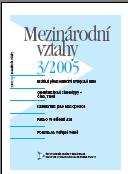Zrcadlo orientalismu –obrazy Tibetu v českém prostředí
The Mirror of Orientalism: Images of Tibet in the Czech context
Author(s): Jana RozehnalováSubject(s): Politics / Political Sciences
Published by: Ústav mezinárodních vztahů
Keywords: Tibet; Buddhism; Orientalism; Shangri-la; Lamaism; Chinese occupation; travel writing; Czech Lands; Czechoslovakia; cultural context
Summary/Abstract: This study deals with Orientalism, focusing on the main aspects of Tibet’s image inthe West, and particularly within Czech society. The first part summarises Tibetologists’ and Buddhologists’ previous research about Western images of Tibet and Tibetan Buddhism. Tibetan Buddhism was initially associated with efforts to distil the “real Tibet” from a mix of romantic images. However, these “imagined Tibets” gradually became the objects of scientific study themselves. Not only do they represent contemporary states of knowledge, but they also reflect the values, expectations, and anxieties of the authors, whether scholars, travellers, or novelists (whose works often employ Tibet as an attractive setting). Tibet’s image is also considerably modified by the political situation at any given historical moment. This article also deals with other images traditionally associated with Tibet, for example its alleged “spirituality” and “wisdom”, showing that Western attitudes towards Tibet, its culture, and its religion have not always been favourable. The beginnings of academic Buddhological and Orientalistic research were noticeably marked by rationalism and historicism, both of which viewed Tibetan Buddhism (“lamaism”) as degenerate ritualism. The original Czech travel accounts from the 1950s, which were supposed to document the political and social changes in Tibet after the Chinese invasion, provide us with a negative image of Tibet as a backward country, fettered by suspicion. The quantity and diversity of the Tibetan images have increased considerably since 1989 to include accounts of the lesser-known side of Tibet, which has been described as the land of omnipotent lamas. The article argues in favour of continuous reflection and examination of such images to form our own attitudes, since “images”, however “imaginary”, have a true impact on real cultural and political relations.
Journal: Mezinárodní vztahy
- Issue Year: 40/2005
- Issue No: 3
- Page Range: 44-62
- Page Count: 19
- Language: Czech

